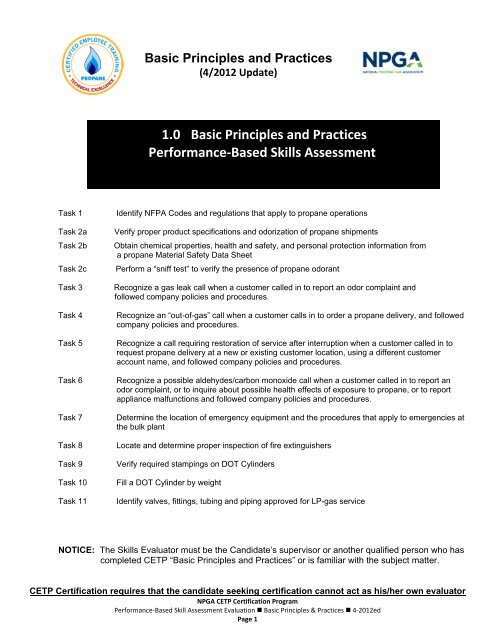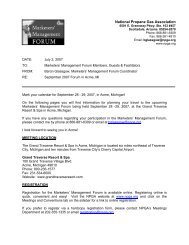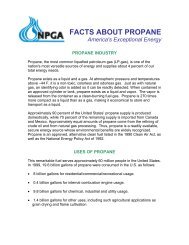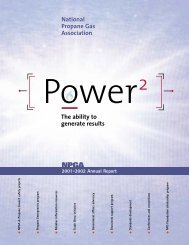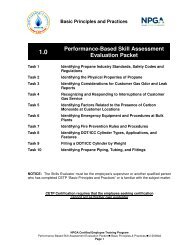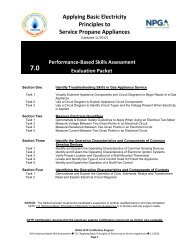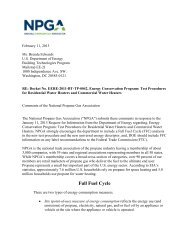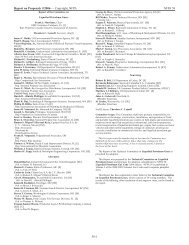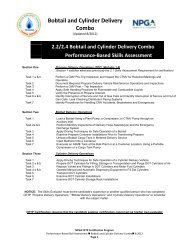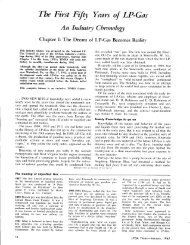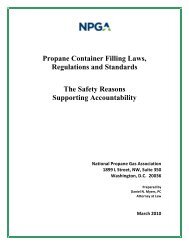1.0 Basic Principles and Practices - National Propane Gas Association
1.0 Basic Principles and Practices - National Propane Gas Association
1.0 Basic Principles and Practices - National Propane Gas Association
You also want an ePaper? Increase the reach of your titles
YUMPU automatically turns print PDFs into web optimized ePapers that Google loves.
Instructions for Use:The Performance Based Skill Assessment Evaluation is designed to st<strong>and</strong>ardize conditions under which thec<strong>and</strong>idate demonstrates performance of tasks to meet the requirements for NPGA CETP Certification.The Skills Assessment should be supplemented with company policies <strong>and</strong> procedures related to each taskbeing evaluated as needed.1. The c<strong>and</strong>idate has 12 months from the date of successfully passing the CETP Certification exam totrain <strong>and</strong> successfully complete the tasks within the evaluation.2. The affidavits <strong>and</strong> a final checklist are provided on the last two pages of the skills packet.Affidavits must be signed by both the c<strong>and</strong>idate <strong>and</strong> the skill evaluatorThe final checklist must be fully completed within 12 months of passing the exam(C<strong>and</strong>idates may use this time to practice skills as often as necessary)Make a copy for the training records when the skills assessment is completed for future audits Send the affidavit page <strong>and</strong> final checklist (last two pages) to the testing center within 12months of passing the exam3. All requirements <strong>and</strong> prerequisites must be met before certification will be granted.<strong>1.0</strong> Certification RequirementsPassing exam score on <strong>1.0</strong> <strong>Basic</strong> <strong>Principles</strong> <strong>and</strong> <strong>Practices</strong> examCompleted <strong>and</strong> signed <strong>1.0</strong> <strong>Basic</strong> <strong>Principles</strong> <strong>and</strong> <strong>Practices</strong> Skills Assessment returned to the testingcenter within 12 months of passing the exam.Users of this material should consult the law of their individual jurisdictions for codes, st<strong>and</strong>ards <strong>and</strong> legal requirementsapplicable to them. This material is not intended to be an exhaustive treatment of the subject, <strong>and</strong> should not beinterpreted as precluding other procedures that would enhance safe LP-gas operations. This training material merelysuggests methods the user may find useful in implementing applicable codes, st<strong>and</strong>ards, <strong>and</strong> legal requirements. Thispublication is not intended nor should it be construed to (1) set forth procedures which are the general custom or practicein the propane industry; (2) to establish the legal st<strong>and</strong>ards of care owed by propane distributors to their customers; or (3)to prevent the reader from using different methods to implement applicable codes, st<strong>and</strong>ards or legal requirements. Thismaterial was designed to be used as a resource only to assist expert <strong>and</strong> experienced supervisors <strong>and</strong> managers intraining personnel in their organizations <strong>and</strong> does not replace federal, state, local, or company safety rules. The user ofthis material is solely responsible for the method of implementation. The <strong>Propane</strong> Education <strong>and</strong> Research Council, the<strong>National</strong> <strong>Propane</strong> <strong>Gas</strong> <strong>Association</strong>, CASTLE Worldwide <strong>and</strong> Industrial Training Services, Inc. assume no liability forreliance on the contents of this training material.Issuance of this material is not intended to nor should it be construed as an undertaking to perform services on behalf ofany party either for their protection or for the protection of third parties.NPGA CETP Certification ProgramPerformance‐Based Skill Assessment Evaluation • <strong>Basic</strong> <strong>Principles</strong> & <strong>Practices</strong> • 4‐2012edPage 2
Instructions for C<strong>and</strong>idate:Practice the operations as many times as needed to become confident <strong>and</strong> proficient with the documents orequipment necessary to complete each task. Your evaluator will check <strong>and</strong> observe your performance, usingthe steps to complete each h<strong>and</strong>s-on operation <strong>and</strong>/or company procedures.The c<strong>and</strong>idate must adhere to all safety precautions. If a safety precaution is violated, then the demonstrationshall be stopped <strong>and</strong> the skills evaluator must instruct the c<strong>and</strong>idate on the proper safety procedures that applybefore allowing the c<strong>and</strong>idate to continue.After completing the skills evaluation, the c<strong>and</strong>idate must fill out the Employee Information section <strong>and</strong> sign theAffidavit.Required information includes the c<strong>and</strong>idate’s last four digits of the SSN to assist the testing center inlocating the correct records.Instructions to the Skills Evaluator:The c<strong>and</strong>idate must adhere to all safety precautions. If a safety precaution is violated, then the demonstrationshall be stopped <strong>and</strong> the skills evaluator must instruct the c<strong>and</strong>idate on the proper safety procedures that applybefore allowing the c<strong>and</strong>idate to continue.Review the tasks within the Skills Evaluation with the c<strong>and</strong>idate.Review all of the instructions, answering any questions <strong>and</strong> explaining how the skills assessment willbe used.Demonstrate <strong>and</strong>/or talk the c<strong>and</strong>idate through each of the steps required to perform each task.Allow the c<strong>and</strong>idate time to ask questions <strong>and</strong>/or study the steps.Observe the c<strong>and</strong>idate performing the required steps, providing corrections as neededAllow the c<strong>and</strong>idate to practice until he/she is confident. Remember: the c<strong>and</strong>idate has 12 months fromthe date of passing the exam to complete <strong>and</strong> return the skills assessmentEvaluate the c<strong>and</strong>idate when readyAfter completing the final checklist, complete the Skills Evaluator information <strong>and</strong> sign the affidavit.Ensure that the Affidavit <strong>and</strong> final Checklist are copied for the Employee Training Records <strong>and</strong> thensent to the testing center.Each task is divided into one or more operations upon which the c<strong>and</strong>idate’s performance is evaluated. Alltasks must be completed unless the “Not Applicable” option is both available for the task <strong>and</strong> applicable to thec<strong>and</strong>idate or the marketer’s present situation. Satisfactory - When all the operations within a task are successfully performed by the c<strong>and</strong>idate accordingthe criteria provided, the evaluator will check off the box marked “Satisfactory.”* Not Applicable – Certain tasks have the “Not Applicable” option available. The Skills Evaluator mustensure the circumstances described under the option are applicable to either the c<strong>and</strong>idate or marketer’spresent situation.NPGA CETP Certification ProgramPerformance‐Based Skill Assessment Evaluation • <strong>Basic</strong> <strong>Principles</strong> & <strong>Practices</strong> • 4‐2012edPage 3
Section One: <strong>Basic</strong> <strong>Principles</strong> <strong>and</strong> <strong>Practices</strong>Task 1:Identify NFPA Codes <strong>and</strong> regulations that apply to propane operationsPerformance Guide: Using copies of NFPA 54, NFPA 58, the Code of Federal Regulations, <strong>and</strong> the other regulatory codes available atthe workplace, the person being evaluated for certification:1. Located <strong>and</strong> identified the Scope of NFPA 58 as found in Chapter 1 of the LP-<strong>Gas</strong> Code.2. Located <strong>and</strong> identified the Scope of NFPA 54 as found in Chapter 1 of the <strong>National</strong> Fuel <strong>Gas</strong> Code.3. Located any applicable state of local codes <strong>and</strong> determined if NFPA 54 <strong>and</strong> 58 are adopted, modified, or referenced by state<strong>and</strong>/or local codes.4. Located any portion of the Code of Federal Regulations <strong>and</strong> found a section that applies to propane of LP-gas operations. SatisfactoryTask 2a:Verify Proper Product Specifications <strong>and</strong> Odorization of <strong>Propane</strong> ShipmentsDocument Used: Actual <strong>Propane</strong> Shipment Bill of Lading (BOL) Facsimile Bill of Lading Included with ChecklistPerformance Guide: The person being evaluated for certification:1. Verified the product name, number of net gallons shipped <strong>and</strong> product vapor pressure noted in BOL.2. Verified the quantity of ethyl mercaptan added to the propane.3. Determined that the specific gravity shown on the bill of lading was within a range of 0.006± (plus or minus) the approximatespecific gravity given for Commercial propane in Table B.1.2.(a), found in Annex B to NFPA 58.4. Determined the amount of ethyl mercaptan added for the net gallons shipped was equal to or greater than the amounts shown inthe chart below.5. Listed the actions required by company procedures if product specifications or odorization is not properly documented. SatisfactoryContinued on next pageNPGA CETP Certification ProgramPerformance‐Based Skill Assessment Evaluation • <strong>Basic</strong> <strong>Principles</strong> & <strong>Practices</strong> • 4‐2012edPage 4
Section One: <strong>Basic</strong> <strong>Principles</strong> <strong>and</strong> <strong>Practices</strong>Task 2a: Verify Proper Product Specifications <strong>and</strong> Odorization of <strong>Propane</strong> Shipments -continuedThe example below may be used for Task 2 if an actual of bill of lading is not available at the work place. SatisfactoryNPGA CETP Certification ProgramPerformance‐Based Skill Assessment Evaluation • <strong>Basic</strong> <strong>Principles</strong> & <strong>Practices</strong> • 4‐2012edPage 5
Section One: <strong>Basic</strong> <strong>Principles</strong> <strong>and</strong> <strong>Practices</strong>Task 2b:Obtain chemical properties, health <strong>and</strong> safety, <strong>and</strong> personal protectioninformation from propane Material Safety Data SheetPerformance Guide: The person being evaluated for certification:1. Obtained a propane MSDS from the work place Hazard Communication Program records.2. Identified the Chemical Abstract Service (CAS) number for propane.3. Identified the section of the MSDS that lists the hazards associated with propane, including each of the NFPA 704 hazardvalues from 0 to 4 for propane’s heath, flammability, <strong>and</strong> reactivity hazards.4. Identified the sections of the MSDS detailing: Health effects First aid measures for exposure to propane Firefighting measures that apply to propane Accidental release of propane H<strong>and</strong>ling <strong>and</strong> storage of propane Exposure control PPE <strong>Propane</strong>’s physical <strong>and</strong> chemical properties5. Identified any other section titles in the MSDS, such as Transportation Information or Regulatory Information, <strong>and</strong> stated tothe evaluator how the information is used on the job. SatisfactoryTask 2c:Perform a “sniff test” to verify the presence of propane odorantPerformance Guide: The person being evaluated for certification:1. Wore appropriate PPE as required by company safety procedures.2. Vented a small quantity of propane.3. Quickly closed the vent valve or outage fitting.4. Sniffed the vaporized propane to determine if odorant was readily perceived.5. Documented the sniff test on appropriate company forms. Satisfactory Not Applicable**Not applicable means that this person’s job description does not require him/her to perform an odorant sniff test in thecourse of his/her duties.Task 3:Recognize a gas leak call when a customer calls in to report an odor complaint <strong>and</strong>follow company policies <strong>and</strong> proceduresEvaluator Note: Calls used in this skill performance evaluation may be actual or simulated customer calls.Performance Guide: the person begin evaluated for certification:1. Informed the customer or caller of company procedures for h<strong>and</strong>ling odor/gas leak calls, communicating any companycustomer warnings or cautionary statements to the caller, <strong>and</strong> specifically directed the customer to evacuate the building <strong>and</strong>to keep unqualified persons out of the structure.2. Correctly identified the service call as an odor/gas leak call on designated company dispatch records.3. Dispatched designated service/delivery personnel <strong>and</strong> clearly communicated that the service call is a priority servicecall/reported gas leak.4. Properly completed any company documentation required. SatisfactoryNPGA CETP Certification ProgramPerformance‐Based Skill Assessment Evaluation • <strong>Basic</strong> <strong>Principles</strong> & <strong>Practices</strong> • 4‐2012edPage 6
Section One: <strong>Basic</strong> <strong>Principles</strong> <strong>and</strong> <strong>Practices</strong>Task 4:Recognize an “out-of-gas” call when a customer calls to order a propane delivery,<strong>and</strong> follow company policies <strong>and</strong> procedures.Evaluator Note: Calls used in this skill performance evaluation may be actual or simulated customer calls.Performance Guide: the person begin evaluated for certification:1. Informed the customer or caller of company procedures for h<strong>and</strong>ling “out-of-gas” calls, communicating any company customerwarnings or cautionary statements to the caller.2. Correctly identified the service call as an “out-of-gas” call on designated company dispatch records.3. Dispatched designated service/delivery personnel <strong>and</strong> clearly communicated that the service call is an “out-of-gas” servicecall.4. Properly completed any company documentation required. SatisfactoryTask 5: Recognize a call requiring restoration of service after interruption of service <strong>and</strong>follow company policy <strong>and</strong> procedures when a customer calls in to requestpropane delivery at a new or existing customer location, using a different accountname.Evaluator Note: Calls used in this skill performance evaluation may be actual or simulated customer calls.Performance Guide: The person being evaluated for certification:1. Informed the customer or caller of company procedures for h<strong>and</strong>ling interruption or new service calls <strong>and</strong> communicated anycompany system inspection services that apply.2. Correctly identified the service call as a new service or interruption of service call on designated company dispatch records.3. Dispatched qualified delivery/service personnel <strong>and</strong> clearly communicated that the service call is a new service call or aninterruption of service call.4. Properly completed any company documentation required. SatisfactoryTask 6:Recognize a possible aldehydes/carbon monoxide call <strong>and</strong> follow companypolicies <strong>and</strong> procedures when a customer calls in to report an odor complaint <strong>and</strong> toinquire about health effects of exposure to propane, or to report an appliancemalfunction.Evaluator Note: Calls used in this skill performance evaluation may be actual or simulated customer calls.Performance Guide: The person being evaluated for certification:1. Informed the customer of company procedures for h<strong>and</strong>ling odor report calls <strong>and</strong> communicated any company warnings orcautionary statements to the caller.2. Correctly identified the service call as an odor/possible CO call on designated company dispatch records.3. Dispatched qualified odor/CO response personnel <strong>and</strong> clearly communicated that the service call is a priority service call/odoror possible carbon monoxide report, along with all other customer reported conditions.4. Properly completed any company documentation required. (If the CO investigation was done by others, such as a firedepartment or HVAC contractor, documented the investigation by recording who conducted the investigation, the time, date<strong>and</strong> results of the investigation.) SatisfactoryNPGA CETP Certification ProgramPerformance‐Based Skill Assessment Evaluation • <strong>Basic</strong> <strong>Principles</strong> & <strong>Practices</strong> • 4‐2012edPage 7
Section One: <strong>Basic</strong> <strong>Principles</strong> <strong>and</strong> <strong>Practices</strong>Task 7:Determine the location of emergency equipment <strong>and</strong> the procedures that applyto emergencies in the bulk plantPerformance Guide: The person being evaluated for certification:1. Obtained a copy of the company emergency response plan for the bulk plant.2. Identified the notification procedures given in the plan as they apply to: Notifying emergency response agencies Notifying company personnel <strong>and</strong> management3. Identified the site evacuation procedures <strong>and</strong> designated off-site gathering places for company personnel.4. Identified the location of all key plant emergency control features.5. Identified exit routes from buildings <strong>and</strong> work areas in the bulk plant, <strong>and</strong> the location of fire extinguishers <strong>and</strong> other safetyequipment located along the exit routes.6. Identified the best exit route to follow from the employee’s primary workstation, accounting for wind direction.7. Stated ignition source control measures that apply in emergencies. SatisfactoryTask 8:Locate <strong>and</strong> determine the proper inspection of fire extinguishersPerformance Guide: The person being evaluated for certification:1. Located fire extinguisher stations in the shop/warehouse area <strong>and</strong> determined if the extinguisher inspections were current.2. Identified the extinguisher manufacturer’s instructions for use. SatisfactoryTask 9:Verify required stampings on DOT cylindersPerformance Guide: The person being evaluated for certification:1. Located the marking that indicates the empty weight of the cylinder.2. Verified that the cylinder is stamped with one of the following DOT or ICC specifications: 4B-240 4BA-240 4BW-240 4E-240 4BA-300 39-2403. Verified that the cylinder is properly marked with the following: Tare weight Water Capacity Serial Number4. Performed the following: Identified Cylinder test date Verified qualification dates.5. Located the following: Manufacturer or trade name Dip Tube length Registered tester’s symbol Cylinder service valve Relief valve The direction that any gas relieved under pressure would be vented from the cylinder. SatisfactoryNPGA CETP Certification ProgramPerformance‐Based Skill Assessment Evaluation • <strong>Basic</strong> <strong>Principles</strong> & <strong>Practices</strong> • 4‐2012edPage 8
Section One: <strong>Basic</strong> <strong>Principles</strong> <strong>and</strong> <strong>Practices</strong>Task 10:Fill a DOT Cylinder by WeightPerformance Guide: The person being evaluated for certification:1. Verified that the dispensing equipment was in good working order <strong>and</strong> met NFPA 58 requirements.2. Opened the liquid outlet valve on storage tank <strong>and</strong> valves in the by-pass return line.3. Verified by visual inspection of the outside of the cylinder that the cylinder was fit for propane service <strong>and</strong> filling.4. Placed scales index at the proper setting.5. Made all required connections <strong>and</strong> filled the cylinder.6. Checked the weight of filled cylinder after the filling connector was disconnected. If overfilled, bled off excess propane in a safelocation.7. Checked the cylinder service valve <strong>and</strong> relief valve for leaks.8. Installed a POL plug or protective cap if so equipped.9. Applied DOT shipping label if one was not already in place <strong>and</strong>/or cylinder warning label if the manufacturer’s label is notlegible, or any other consumer or commercial warning label required by company procedures. Satisfactory Not Applicable**Not applicable means that this person’s job description does not include any duty such as filling a DOT cylinder byweight.Task 11:Identify valves, fittings, tubing, <strong>and</strong> piping approved for LP-gas servicePerformance Guide: In the shop or warehouse or by using manufacturer pictures, the person being evaluated for certification:1. Obtained a container service valve, or other service fitting <strong>and</strong> determined which of the following manufacturing st<strong>and</strong>ardsapplied to the valve of fitting:ULASTM2. Obtained a section of polyethylene pipe or tubing or a section of corrugated stainless steel tubing <strong>and</strong> determined which of thefollowing manufacturing st<strong>and</strong>ards applied to the pipe or tubing:ULASTM3. Determined from shipping cartons or coil covers whether copper tubing stored in the shop or warehouse is Type L or Type Kor Type R.4. Obtained steep pipe nipples from the shop or warehouse inventories <strong>and</strong> determined whether the pipe nipples were schedule40 or schedule 80.5. Correctly identified whether threaded schedule 40 piping can be used to contain propane in a liquid state <strong>and</strong>/or at unregulatedtank pressure. Satisfactory Not Applicable**Not applicable means that this person’s workplace does not have any of the materials needed for this performance evaluation, <strong>and</strong>/orthe person’s job description does not include any duty as installation or inventory control ( ordering, receiving, storing or classifying forinventory purposes) that requires the person to verify that installation materials or container fittings are approved for propane service.NPGA CETP Certification ProgramPerformance‐Based Skill Assessment Evaluation • <strong>Basic</strong> <strong>Principles</strong> & <strong>Practices</strong> • 4‐2012edPage 9
Step 1: Successfully pass the examCETP Performance Evaluation / Employer Record (<strong>1.0</strong>)Completing your CETP CertificationStep 2: Complete <strong>and</strong> return the CETP Performance Evaluation / Employee Record to the testing center belowwithin 12 months of passing the examStep 3: Complete any necessary prerequisites within 12 months of passing the examMake a copy for your training records <strong>and</strong> then send the original to:Industrial Training Services, Inc.310 CC Lowry DriveMurray, KY 42071PH: 270-753-2150Fax: 270-753-9807The information requested below will be used to assist in locating your records in the CETP database.Please make sure to complete all requested information; we thank you in advance for your assistance.Employee Information: (print or type) Test Group Number (if known): ___________________________Name _____________________________________________________ Last four digits of SSN (only) ____________Employer ___________________________________________________________________________Address _________________________________________________Daytime Phone# _____________________City, State: ______________________________________________________ Zip Code _________________AffidavitI affirm that I am the person who has performed those items checked on this checklist. I acknowledge that theperformance checklists used are solely for the purpose of skills assessment for the CETP certification requirements, <strong>and</strong>are not intended to replace or modify company operating or safety procedures, <strong>and</strong> may not be appropriate for use in allcircumstances. I acknowledge that I am responsible for recognizing hazards <strong>and</strong> abnormal conditions in my workplace<strong>and</strong> must exercise care <strong>and</strong> good judgment, always using appropriate equipment, procedures <strong>and</strong> tools for the tasks Iperform. The <strong>Propane</strong> Education <strong>and</strong> Research Council, the <strong>National</strong> <strong>Propane</strong> <strong>Gas</strong> <strong>Association</strong>, CASTLE Worldwide <strong>and</strong>Industrial Training Services, Inc. assume no liability for my actions, or for my application of the skills assessmentperformance guides used in this evaluation checklist.Employee’s Signature__________________________________________________ Date_________________Skills Evaluator Information: (print or type)Name ___________________________________________________________________________________Organization/Employer_______________________________________________________________________AffidavitI affirm that I am the person who has administered this checklist, <strong>and</strong> that I have conducted this Employee SkillsAssessment with integrity. I also affirm that the above named employee is the person whose performance I evaluated,<strong>and</strong> that the above named person performed the checked tasks at the indicated level without assistance from me or anyother person.Skill Evaluator’s Signature _______________________________________________________ Date __________Name __________________________________________________________Last four digits of SSN (only) ________NPGA CETP Certification ProgramPerformance‐Based Skill Assessment Evaluation • <strong>Basic</strong> <strong>Principles</strong> & <strong>Practices</strong> • 4‐2012edPage 10
The employee has been evaluated on the following tasks at the following level:(N/A option available only as listed in Not Applicable column box(s) below)SatisfactoryNotApplicableIdentify NFPA Codes <strong>and</strong> regulations that apply to propane operations.Verify proper product specifications <strong>and</strong> odorization of propane shipments.Obtain chemical properties, health <strong>and</strong> safety, <strong>and</strong> personal protection informationfrom the propane Material Safety Data Sheet.Perform a “sniff test” to verify the presence of propane odorant.Recognize a gas leak call when a customer calls in to report an odor complaint, <strong>and</strong>follow company policies <strong>and</strong> procedures.Recognize an “out-of-gas” call when a customer calls in to order a propane delivery,<strong>and</strong> follow company policies <strong>and</strong> procedures.Recognize a call requiring restoration of service after interruption when a customercalls in to request propane delivery at a new or existing customer location, using adifferent customer account name, <strong>and</strong> follow company policies <strong>and</strong> procedures.Recognize a possible aldehydes/carbon monoxide call when a customer calls in toreport an odor complaint or to inquire about possible health effects of exposure topropane or to report appliance malfunctions, <strong>and</strong> follow company policies <strong>and</strong>procedures.Determine the location of emergency equipment <strong>and</strong> the procedures that apply toemergencies in the bulk plank.Locate <strong>and</strong> determine proper inspection of fire extinguishers.Verify required stampings on DOT cylinders.Fill a DOT Cylinder by WeightIdentify valves, fittings, tubing <strong>and</strong> piping approved for LP-gas service.Completing your CETP CertificationStep 1: Successfully pass the examStep 2: Complete <strong>and</strong> return the CETP Performance Evaluation / Employee Record to the testing center belowwithin 12 months of passing the examStep 3: Complete any necessary prerequisites within 12 months of passing the examMake a copy for your training records <strong>and</strong> then send the original to:Industrial Training Services, Inc.310 CC Lowry DriveMurray, KY 42071PH: 270-753-2150Fax: 270-753-9807NPGA CETP Certification ProgramPerformance‐Based Skill Assessment Evaluation • <strong>Basic</strong> <strong>Principles</strong> & <strong>Practices</strong> • 4‐2012edPage 11


